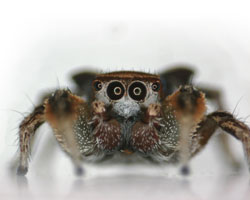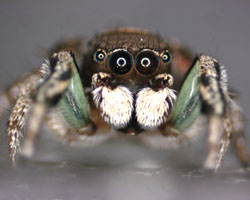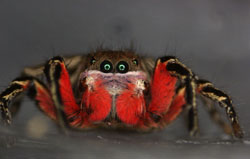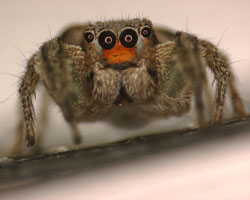
|
| Illustration: Meghan Rock |
| Complex vibrations can make or break the courtship dances of spiders. Helen Shen joins Berkeley biologists to watch. Illustrated by Meghan Rock. |
 |
Rrrr… RRR… Thack! Thack! Thrusting his front legs skyward, the male jumping spider shakes his rear end to send thumps, scrapes, and buzzes through the ground. He’s playing for a female’s attention, dazzling her eight eyes with semaphore while drumming out seductive seismic signals. A few missteps could turn the spider’s performance into a dinner show—with the star as the main dish. The ferocious female demands precise choreography, set to a groovy beat that UC Berkeley behavioral ecologist Damian Elias is working to decipher.
Scientists had long believed that female jumping spiders judged their suitors on looks alone. Indeed, two marble-like eyes placed front and center are perfectly suited to detect the male’s outlandish markings—sometimes scarlet, mustard, and even electric blue. Researchers first collected subtle purrs from the males’ energetic rump-shaking about 30 years ago. But their sound equipment only revealed audible vibrations—a mere sliver of the earless spiders’ seismic range. No one knew their purpose.
In the early 2000s, Elias and a handful of scientists first unlocked an underground world of communication among spiders and a host of other tiny creatures. Laser technology once reserved for industrial engineers and spies unveiled this hidden realm. Elias discovered that seismic songs serve as more than background music for jumping spider courtship. Rather, they help the female decide between “Yes” and “NOM NOM NOM.”
|
All spider photos:
Damian Elias, UC Berkeley |
|
|
Many animals send and receive signals through the ground. Elephants use their toes to sense trumpets and stomps of faraway friends. Golden moles target bite-sized termites by feeling the bugs’ footsteps. Some South American frogs thump the ground with their bulging air sacs to greet mates and rivals.
Researchers like Elias have begun to realize that many spiders and their kin—known collectively as arthropods—use seismic communication, too. The tiny animals often lack the muscle power to vibrate air into audible sounds. An estimated 70 to 80 percent of these creatures get by with pulsing solid objects instead. Different objects vibrate differently, and only certain materials set the stage for spider love, says Elias. He’s discovered that males in different regions win their mates with particular patterns, akin to seismic dialects, played on just the right turf.
Getting into the movies
Elias (pronounced eh-LEE-ahs), who is of Mexican descent, grew up in Nogales, Arizona—just an hour’s drive from the Atascosa Mountains where he would later return to collect spiders. Summers spent on his father’s cattle ranch introduced Elias to nature as a boy, but for years he dreamed of becoming a moviemaker. In college, an evolutionary biology class—taught by University of Arizona spider expert Wayne Maddison—directed Elias’s lens toward spiders instead.
 Photo: Helen Shen Photo: Helen Shen |
UC Berkeley behavioral ecologist Damian Elias. (Click image to see larger version.) |
|
|
“I became fascinated with how brains put together information, how it’s different for different organisms,” says Elias. The 37-year-old researcher remains captivated by how other animals, especially those with tiny nervous systems, sense the world around them. He first studied how moths taste their food and how aphids sniff out their mates. Once bitten, twice hooked, Elias reconnected with spiders as a Cornell University graduate student when his advisor, Ronald Hoy, visited Maddison while on a sabbatical.
Maddison showed Hoy new high-speed footage of jumping spider courtship that provided fresh evidence for seismic signaling. The silent videos revealed the tiny animals—about 4 millimeters long—performing abdominal calisthenics. The males’ hindquarters waggled separately from the leg-waving routine, but stayed out of the females’ view. Maddison reasoned that the physically demanding moves served some hidden purpose, and he encouraged Elias to decode them. With a passion for tinkering and a stroke of technological luck, Elias launched his career by exposing seismic soundtracks for jumping spider courtship.
“He found a level of vibrational communication that we never knew existed,” says behavioral ecologist George Uetz, who studies wolf spiders at the University of Cincinnati.
Stage fright
For many outsiders, spiders incite terror, to say nothing of spiders that jump. In the Elias lab, however, jumping spiders play the role of a beloved mascot. Drawn, painted, and Lego-constructed arachnids adorn the bookshelves, doorways, and even overhead lights of the otherwise minimalist rooms. Only three years old, Elias’s lab is still filling out with computers and people.
From under a mop of wavy brown hair, Elias smiles sheepishly as he likens his subjects to adorable kittens. (It must be their furry bodies and saucer-like eyes, he says.) But in the spider world, jumping spiders act more like cougars. They use color 3-D vision from their eight eyes to stalk and pounce on their prey—other bugs, and even other spiders.
 Elias and his graduate student, Madeline Girard, hunt for jumping spiders each summer in the mountains of Arizona and grasslands of Australia. Spotting the little buggers can tax the eyes and the back, says Elias, pushing up his thick black-framed and slightly smudged glasses. He demonstrates by shuffling slowly around his office, hands behind his back, hunched over like an old man. He approaches slowly at first. Then, with a quick flick of the wrist, Elias inverts a skinny glass vial to capture the spider. On a good day, he can catch about 25 in an hour. Back in the lab, the animals live in what postdoctoral researcher Patrick Kelley affectionately terms the “spider hotel.” Inside clear plastic cases stacked neatly on shelves, it’s single occupancy only for the aggressive and solitary spiders. Elias and his graduate student, Madeline Girard, hunt for jumping spiders each summer in the mountains of Arizona and grasslands of Australia. Spotting the little buggers can tax the eyes and the back, says Elias, pushing up his thick black-framed and slightly smudged glasses. He demonstrates by shuffling slowly around his office, hands behind his back, hunched over like an old man. He approaches slowly at first. Then, with a quick flick of the wrist, Elias inverts a skinny glass vial to capture the spider. On a good day, he can catch about 25 in an hour. Back in the lab, the animals live in what postdoctoral researcher Patrick Kelley affectionately terms the “spider hotel.” Inside clear plastic cases stacked neatly on shelves, it’s single occupancy only for the aggressive and solitary spiders.
In the wild, a courting male sidles up to a female gradually, scuttling in wide arcs from a safe distance of 20 to 25 body lengths away. If he detects interest, the male rocks back and forth more quickly while moving closer. At about two body lengths, the male bravely begins to dance. Depending on the species, an interested female might enjoy a 15-second dance or a one-hour marathon performance. But an uninterested female may leap on her hapless suitor and stab him with her fangs. Through his crunchy exoskeleton, the female injects the male with enzymes that dissolve his innards. She then slurps a leisurely liquid meal that can last 15 minutes, leaving behind a furry shell with eyeballs.
Still, these fierce hunters can be shy and, well, jumpy. “Don’t move, okay?” says Kelley, tapping a small plastic container to release a reluctant male—about the size of a small lentil—into my palm. The pale brown spider with a black striped abdomen finally pops out, legs splayed. At a distance of about six inches, I can make out the two largest eyes on the spider’s head. I hold my breath and speak in whispers. Any sudden jolt, a tremble even, could tempt the animal to jump. Kelley’s afraid of losing the tiny spider into the room. I’m afraid of losing the spider into my hair.
 “They almost always escape,” says Elias, laughing. During experiments, he ushers the male spider toward a waiting female with a paintbrush. If the male doesn’t see his target right away, he’s likely to get spooked and jump, up to four body lengths in a single bound. Sometimes the best solution is to leave the room for an hour, says Elias. The skittish spiders often seek the highest ground, perhaps to survey their surroundings. “If you just keep looking at the tops of lights or the tops of tripods, you’ll usually find them there,” he says. “They almost always escape,” says Elias, laughing. During experiments, he ushers the male spider toward a waiting female with a paintbrush. If the male doesn’t see his target right away, he’s likely to get spooked and jump, up to four body lengths in a single bound. Sometimes the best solution is to leave the room for an hour, says Elias. The skittish spiders often seek the highest ground, perhaps to survey their surroundings. “If you just keep looking at the tops of lights or the tops of tripods, you’ll usually find them there,” he says.
Sex, lasers, and videotape
Once he wrangles spiders into their place, Elias fires up his favorite lab toy—a laser vibrometer. First developed in the 1960s, the instrument beams laser light at surfaces, then detects when surface vibrations stretch and compress the beam’s reflection off the material. Spies use this technique to eavesdrop on indoor conversations from outside a building. In 2011, Osama bin Laden’s fate was sealed when the CIA detected his voice vibrating on the windows of a compound in Pakistan. Elias uses the laser vibrometer to spy on spiders. He translates the reflected laser-light wobbles into sound waves through a speaker, playing the spider vibrations as seismic “songs.”
It’s a big improvement over his initial homemade solutions. After seeing Wayne Maddison’s videos, Elias first started measuring vibrations with a re-jiggered phonograph needle. Rather than picking up grooves on a record, the needle jumped in time with the spider’s movements on a small paper stage. But the makeshift setup yielded unreliable recordings.
 Near the end of graduate school, Elias learned that a colleague was opening a new lab at the University of Toronto, equipped with a laser vibrometer. “It was like, ‘As soon as you take it out of the box, I’m going to be in your lab with some spiders,’” says Elias. He packed up for a postdoctoral fellowship in Canada, where he performed the vibrometry experiments that would become his signature work. Near the end of graduate school, Elias learned that a colleague was opening a new lab at the University of Toronto, equipped with a laser vibrometer. “It was like, ‘As soon as you take it out of the box, I’m going to be in your lab with some spiders,’” says Elias. He packed up for a postdoctoral fellowship in Canada, where he performed the vibrometry experiments that would become his signature work.
In the wild, jumping spiders dart among haphazard piles of leaves, rocks, twigs, and sand. Elias needed to find the right man-made surface on which to measure spider vibrations in the lab. Graph paper and aluminum proved too stiff, ringing like tuning forks with ambient noises and air currents. Through trial and error, Elias designed his mating “stage”: a piece of flesh-toned nylon pantyhose pulled taut over a 6-inch embroidery hoop. Shining his laser on the nylon stage while filming the dancing spiders, Elias became the first to detail the jumping spider’s romantic rhythms in a 2003 publication.
Other researchers recorded seismic signals in different spiders, such as the wolf spider, around the same time. But jumping spiders—with their colorful markings, flamboyant dance moves, and vibratory signals—have it all. Elias delights in the complexity of their communications.
Swagger and style
The spiders can send vibrational messages as sophisticated as any songbird’s tune, says Elias. With the laser vibrometer, he’s found that different species string together seismic signals in unique sequences and tempos. In their papers, the lab has coined colorful terms like “crunch-rolls” or “rumble-rumps” to identify the strange-sounding motifs.
|
Watch a video of a jumping spider experiment from Damian Elias's lab at UC Berkeley |
|
|
A jumping spider shakes the ground by tapping its rear end or, more often, by scraping a file-like structure on its body against stiff bristles on its abdomen. In many species, only males send vibrational signals—sometimes for love, sometimes for war against other males. Spiders of both sexes detect vibrational signals with “slit sense” organs, named for their grooved appearance, similar to a shark’s gills. Located near the leg joints, slit sense organs flex like tiny shock absorbers to pick up rumblings from the ground.
One species revs like a motorcycle engine, with a “brrm brrm brrm” that grows louder and faster as the male prepares to mount the female. Another species plays a “tack-tack-tack—brrrrrrr” sequence, like manual typewriter with a noisy carriage return. The peacock spider makes a simple “wop wop wop” like a sheet of plastic flopping back and forth.
Different species not only use distinct vibrational components, but they play their songs with different styles. Elias terms the Habronattus genus the jazz musicians of jumping spiders because each male arranges the same seismic elements in a different order. He calls the Phidippus genus tribal drummers for their use of basic, repetitive beats.
So far, Elias has discovered that different patterns and intensities of vibrations can signal a male’s body size, recent diet, or health. The significance of many seismic components remains a mystery.
What a girl wants
Jumping spiders make up the largest arachnid family, with about 5,000 described species worldwide. Elias and others have exploited this astonishing diversity to tackle some tough questions—including what the finicky females look for in a male’s performance.
Elias has found that female spiders take note when males from neighboring regions use similar but different seismic “dialects.” Jumping spiders in the Atascosa Mountains and the Santa Rita Mountains of Arizona both court with visual and vibrational signals, but they never meet in the wild. In the lab, Elias and others discovered that Santa Rita females prefer the exotic Atascosa males over their native dating pool. Atascosa females, on the other hand, stick with their local suitors.
 With laser vibrometry, Elias showed that Atascosa males produce more varied and more complex seismic signals than the Santa Rita males can muster. Speculating that females award bonus points for vibrational artistry, Elias silenced the males by gluing their hindquarters in place with a dollop of wax. The wax blocked seismic signals in both species while leaving their flashy leg-waving displays intact. Robbed of their seismic instruments, Atascosa males lost their advantage over the Santa Rita suitors. Elias’s discovery helped confirm that females pay particular attention to vibrational signals, and that some species may prefer the most novel patterns. With laser vibrometry, Elias showed that Atascosa males produce more varied and more complex seismic signals than the Santa Rita males can muster. Speculating that females award bonus points for vibrational artistry, Elias silenced the males by gluing their hindquarters in place with a dollop of wax. The wax blocked seismic signals in both species while leaving their flashy leg-waving displays intact. Robbed of their seismic instruments, Atascosa males lost their advantage over the Santa Rita suitors. Elias’s discovery helped confirm that females pay particular attention to vibrational signals, and that some species may prefer the most novel patterns.
Still, a fancy dance can fail if performed in the wrong venue. As a graduate student, Elias collected Atascosa spiders from among rocks, sand, and dried leaves. In the lab, he placed pairs of males and females on surfaces constructed entirely of only one of the three materials. Unfazed, the males vied for female attention on all three surface types. But females mated almost exclusively when courted on piles of leaf litter. Elias’s tests suggested rocks were too tough for the males to budge. Sand filtered out the frequencies males used. Dried leaves proved just right, allowing the males’ signals to sing through.
Elias believes these males and females have evolved what amounts to a spider dating service: matching signals and preferences to help meet one another among leaf piles. But why might jumping spiders—or any animal, for that matter—restrict their romantic opportunities to a single surface? Ecologists suspect that spiders and their terrestrial neighbors may have evolved strategies to each keep their signals straight. One critter’s mating song might sound sweet when played on leaves, while another's is mere noise when performed on the same instrument. Different animals may adapt their messages to specific platforms to identify mates with less chatter from outsiders.
 Combining careful fieldwork with clever lab experiments has earned Elias respect from his peers. Behavioral ecologist Rafael Rodriguez of the University of Wisconsin–Milwaukee admires Elias’s work as a modern-day evolutionary theorist with solid roots in old-school natural history. “He can give you the evolutionary account, but he can also give you a very detailed mechanistic description of how the signals are transmitted,” says Rodriguez. “Very few people in the field can do both of those things as well as he can.” Combining careful fieldwork with clever lab experiments has earned Elias respect from his peers. Behavioral ecologist Rafael Rodriguez of the University of Wisconsin–Milwaukee admires Elias’s work as a modern-day evolutionary theorist with solid roots in old-school natural history. “He can give you the evolutionary account, but he can also give you a very detailed mechanistic description of how the signals are transmitted,” says Rodriguez. “Very few people in the field can do both of those things as well as he can.”
Graduate student Madeline Girard will soon test whether females steer the males’ performances by offering visual cues along the way. For now, she’s waiting for spring. There aren’t enough males left in the lab for more experiments. Dissatisfied females consume 25 percent of the males mid-dance, and the rest perish within a year. In captivity, the males die about six months earlier than the females—perhaps because they exhaust so much energy on courtship.
As the season’s last male stares into Elias’s camera, the tiny spider stands unaware of his role in solving a giant evolutionary puzzle. He represents only one jumping spider species that Elias plans to characterize. By studying many species, Elias hopes to find common evolutionary rules that explain why male and female spiders establish such complex communications.
Jumping spiders are just the beginning, says Elias. They contribute only a few thousand species to the million or so known arthropods. “We have no idea how the majority of life on earth is using these vibrations,” says Elias. “You start listening in on them, and it’s like getting a window into this secret world.”
Story ©2012 by Helen Shen. For reproduction requests, contact the Science Communication Program office.
Top
Biographies
 Helen H. Shen Helen H. Shen
B.S. (biology, minor: psychology) Stanford University
Ph.D. (neuroscience) University of California, San Francisco
Internships: Boston Globe (Kaiser Family Foundation health reporting internship); Nature (Washington, D.C.)
The brain can do a lot in 250 milliseconds. Simply reaching for a morning coffee requires signals so complex that I still haven't cracked the code, even after seven years of trying.
I entered neuroscience research hoping to learn how electrical impulses in our heads define us as humans. Staring at the data, however, I realized it would take several lifetimes to explain arm movements, to say nothing of artistic expression.
Science writing became my refuge, allowing me to explore the scientific world at an accelerated pace. Last summer, at the Philadelphia Inquirer, I jumped at the chance to cover multiple topics each day, sometimes reporting on organ donation in the morning and nanotechnology in the afternoon. These days, my next great story idea feels like it's just fractions of a second away.
. . . . . . . . . . . . . . . . . . . . . . . . . . . . . . . . . . . . . . . . . . . . . . . . . . .

Meghan Rock
B.A. (creative writing) Columbia College, Chicago
Internships: Field Museum of Chicago; University of California, Riverside
 I'm a Chicago-native with a yearning for oceans. After a lifetime of admiring cephalopods and other marine invertebrates, I ended up studying and working at the University of Washington marine field station in Friday Harbor. When I'm not drawing, I spend time with a persnickety Siamese cat named Momo, design my own knitting patterns, and devour all the books and movies I can get my hands on. I'm a Chicago-native with a yearning for oceans. After a lifetime of admiring cephalopods and other marine invertebrates, I ended up studying and working at the University of Washington marine field station in Friday Harbor. When I'm not drawing, I spend time with a persnickety Siamese cat named Momo, design my own knitting patterns, and devour all the books and movies I can get my hands on.
Top
|

